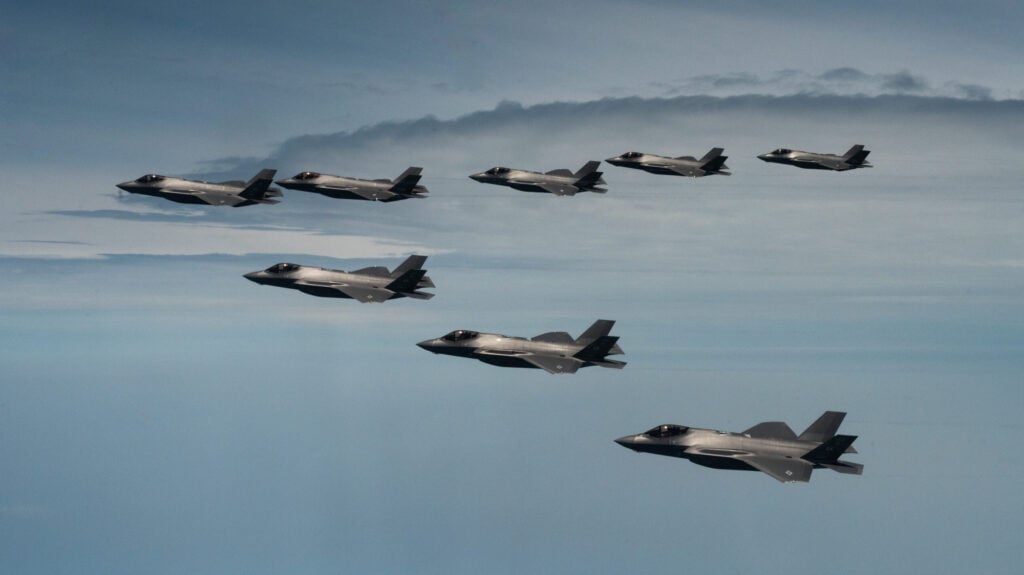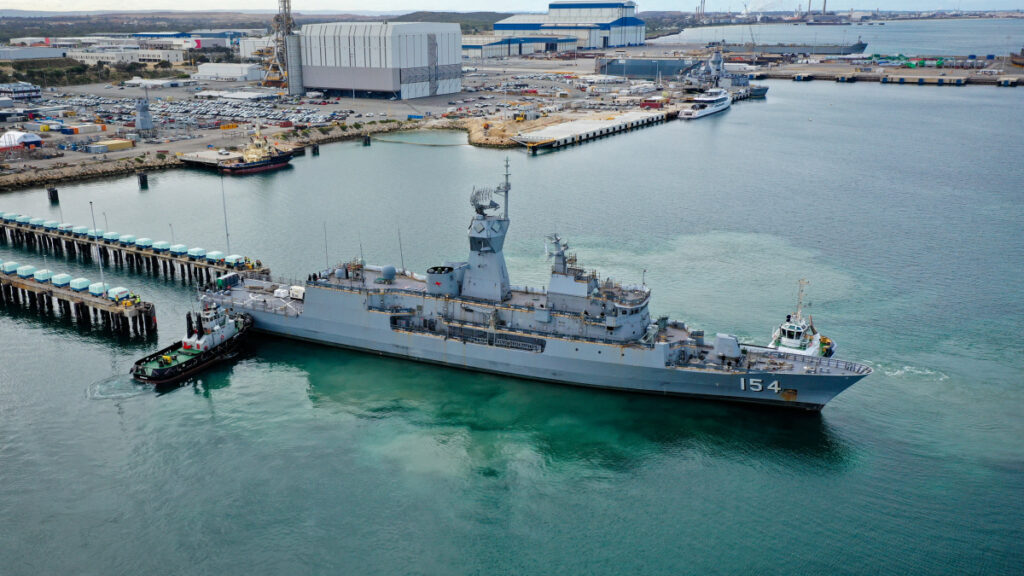U.S. Air Force F-35 Lightning IIs from the 356th Fighter Squadron at Eielson Air Force Base fly side by side with Republic of Korea Air Force F-35s from the 151st and 152nd Combat Flight Squadrons as part of a bilateral exercise over the Yellow Sea, Republic of Korea, July 12, 2022. (U.S. Air Force photo by Senior Airman Trevor Gordnier)
WASHINGTON — The House Appropriations Committee has laid out an $833 billion defense budget proposal that abides by Congressionally-mandated spending caps, adds funds for more F-35s and aid for Israel, and blocks a proposal to transfer Guard personnel to the Space Force.
The bill realigns $18 billion in funds requested in President Joe Biden’s budget proposal — in part by cutting $916 million for Pentagon civilian jobs, $621 million for climate change initiatives and $53 million associated with diversity and inclusion training — transmitting that money instead to GOP-friendly programs such as countering drug trafficking.
“In a resource and time constrained environment, my top priority for the Fiscal Year 2025 Defense Appropriations Bill is to strengthen our military’s position against any threat presented by China,” said California Rep. Ken Calvert, chairman of the House Appropriations defense subcommittee, which will take up the spending proposal on Wednesday.
“Every dollar counts within the topline limitation imposed by the Fiscal Responsibility Act. Therefore, this bill withholds funds from initiatives and programs that are wasteful, inefficient, or do not contribute directly to our national security.”
Israel also received a boost in aid, with appropriators adding $80 million for US-Israeli anti-tunneling cooperation and $55 million for counter-UAS development and directed energy cooperation.
Another big winner was the Pentagon’s Defense Innovation Unit, which scooped up a $220 million increase to field tech that meets combatant commander priorities and $240 million to field other technologies needed by the services. DIU also got a $45 million addition in funds for classified facilities.
The Pentagon’s research and development budget received a $2.7 billion boost to $145.9 billion, but still is $2.4 billion lower than the FY24 budget. Overall procurement took a hit, with funding cut by $1.4 billion to $165.3 billion, or about $6.7 billion lower than the current fiscal year.
Procurement Winners And Losers
Despite the cuts to weapons procurement, aircraft programs fared relatively well in the spending proposal.
In terms of weapons programs, the big winner was Lockheed Martin’s F-35. Despite cuts to planned procurement that reduced the Pentagon’s request to 68 jets in FY25, House Appropriators opted to restore eight jets — two F-35A models and six F-35C carrier takeoff and landing models — bringing the total buy to 76.
House appropriators added funds for two HH-60W combat rescue helicopters for the Air Force and two C-130Js for the Air National Guard, thus extending procurement funds for two platforms the Air Force had not requested to buy this year. The bill also added another CH-53K helicopter for the Marine Corps.
The bill rejected the Air Force’s proposed retirements of the U-2 spy plane as well as “certain” F-15 divestments, and boosted funds for the Next Generation Air Dominance program to $3.3 billion.
In shipbuilding, House appropriators funded two Arleigh Burke-class guided missile destroyers, one San Antonio-class amphibious transport dock, and one Virginia-class submarine — a notable difference from the House Armed Services Committee’s version of the defense policy bill, which authorized additional advanced procurement funding for a second ship.
In another significant omission, the spending bill and its summary do not lay out any funding for the Constellation-class frigate. The Navy requested about $1 billion in funds for the first ship in FY25, but it appears House appropriators may follow the HASC in zeroing out funding.
In terms of land vehicles, the bill funds upgrades to Abrams tanks for $700 million, buys 33 Booker combat vehicles for $460 million, and spends $576 million on M109A6 Paladin Self-Propelled Howitzers and M992A2 Field Artillery Ammunition Support Vehicles.
The Space Force’s $29.4 billion request was cut slightly to $28.6 billion, with reductions of about $400 million to both procurement and research and development accounts.
House appropriators also slapped down the Department of the Air Force’s proposed move of National Guard space units into the Space Force. Because the bill summary and text does not lay out explicit language laying out the exact scope of the prohibition, it remains to be seen how it compares with the language approved by HASC, which would allow the Space Force to absorb National Guard space units, but only if approved by that state’s governor.
Other funding additions included a $123.1 million increase for hypersonic test facilities, another $242 million for drug interdiction activities, $20 million for counternarcotics programs meant to counter fentanyl and opioid trafficking, and $12 million for counter-drug train and equip programs with Mexico.
Many of the funding cuts and policy proposals laid out in the bill summary are aimed at achieving larger GOP policy objectives, such as provisions that would prohibit funds to be used for “medical procedures that attempt to change an individual’s biological gender” or prohibitions on paid leave for federal employees who travel out of state to receive an abortion.
In a note to investors, Byron Callan of Capital Alpha Partners wrote that “The outcome of these cuts and culture war provisions depends on the outcome of the 2024 U.S. election.”
The Path Forward
The release of the spending proposal comes two weeks after the House Armed Services Committee passed its $883 billion defense authorization bill, a separate measure from the appropriations bill that provides spending recommendations and lays out larger policy changes.
While both House appropriators and authorizers chose to keep the defense budget inside the limits imposed by last year’s Fiscal Responsibility Act, some key leaders on the Senate defense committees have suggested they would support breaking those congressionally-mandated spending caps.
Last week, Sen. Roger Wicker, the top Republican on the Senate Armed Services Committee, revealed a defense plan aimed at raising defense spending to 5 percent of the gross domestic product, starting with adding $55 billion to the FY25 defense budget.
Sens. Jon Tester, the Montana Democrat who chairs the defense subcommittee, and Susan Collins, the ranking Republican on the Senate Appropriations Committee, have stated that they want to bust the budget caps to allow for higher defense spending. Senate Appropriations Committee chairwoman Patty Murray, D-Wash., the chair of the full Appropriations Committee, has indicated that she might support an increase to defense spending if it came with a spending boost to nondefense programs.
The full House Appropriations Committee is slated to vote on its spending proposal next week after the defense subcommittee takes it up Wednesday.
Theresa Hitchens, Justin Katz, Ashley Roque and Michael Marrow all contributed to this report.






![The sights from the 2024 Farnborough Airshow [PHOTOS]](https://centurionpartnersgroup.com/wp-content/uploads/2024/07/IMG_8722-scaled-e1721930652747-1024x577-hZjwVb-500x383.jpeg)




